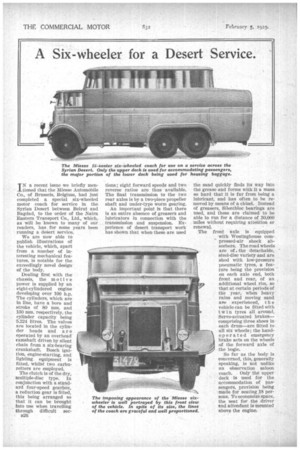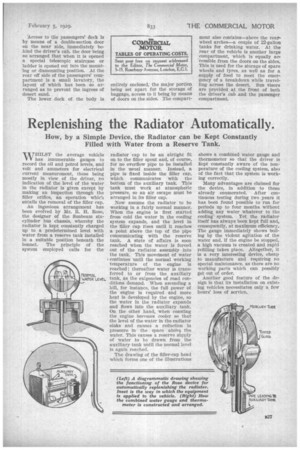I N a recent issue we briefly mentioned that the Miesse
Page 10

Page 11

If you've noticed an error in this article please click here to report it so we can fix it.
Automobile Co., of Brussels, Belgium, had just completed a special six-wheeled motor coach for service in the Syrian Desert between Beirut and Bagdad, to the order of the Nairn Eastern Transport Co., Ltd., which, as will be known to many of our readers, has for some years been running a desert service.
We are now able to publish illustrations of the vehicle, which, apart from a number of interesting mechanical features, is notable for the exceedingly novel design of the body.
Dealing first with the chassis, the motive power is supplied by an eight-cylindered engine developing over 100 h.p. The cylinders, which are in line, have a bore and stroke of 80 mm. and 130 ram. respectively,, the cylinder capacity being 5.224 litres. The valves are located in the cylinder heads and are operated by an overhead camshaft driven by silent chain from a six-bearing crankshaft. Bosch ignition, engine-starting, and lighting equipment is fitted, whilst two carburetters are employed.
The clutch is of the dry, multiple-disc type. In conjunction with a standard four-speed gearbox, a reduction gear is fitted, this being arranged so that it can be brought Into use when travelling through difficult sec s26 tions; eight forward speeds and two reverse ratios are thus available. The final transmission to the two rear axles is by a two-piece propeller shaft and under-type worm gearing.
An important point is that there is an entire absence of greasers and lubricators in connection with the transmission and suspension. Experience of desert transport work has shown that when these are used
the sand quickly finds its way into the grease and forms with it a mass so hard that it is far from being a lubricant, and has often to be removed by means of a chisel. Instead of greasers, Silentbloc bearings are used, and these are claimed to be able to run for a distance of 30,000 miles without requiring attention or renewal.
The front axle is equipped with Westinghouse compressed-air shock absorbers. The road wheels are of • the detachable, steel-disc variety and are shod with low-pressure pneumatic tyres, a feature being the provision on each axle end, both front and rear, of an additional wheel rim, so that at certain periods of the year, when heavy rains and moving sand aike experienced, t Ii e vehicle can be fitted with twin tyres all around. Servo-actuated brakes— comprising three shoes in each drum—are fitted to all six wheels; the handoperated emergency brake acts on the wheels of the forward axle of the bogie.
So far as the body is concerned, this, generally speaking, is not unlike an observation saloon coach. Only the upper ' deck is used for the accommodation of passengers, provision being -made for seating ,18 persons. To economize space, the seat for the driver and attendant is mounted above the engine. Access to the passengers' deck is by means of a double-section door on the near side, immediately behind the driver's cab, the door being so arranged that when it is opened a special telescopic staircase or ladder is opened out into the mounting or dismounting position. At the rear off side of the passengers' compartment is a small lavatory, the layout of which has been so arranged as to prevent the ingress of desert sand.
The lower deck of the body is entirely enclosed, the major portion being set apart for the storage of baggage, access to it being by means of doors on the sides. The compart ment also contains—above the rearwheel arches—a couple of 22-gallon tanks for drinking water. At the rear of the vehicle is another large compartment, which is equally accessible from the doors on the sides. This is used for the storage of spare wheels and tyres, as well as for a supply of food to meet the emergency of a breakdown while travelling across the desert. Sun visors are provided at the front of both the driver's cab and the passenger compartment. .1


































